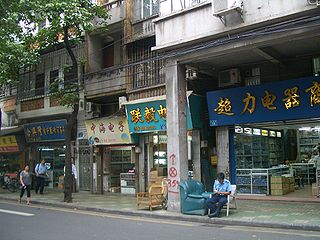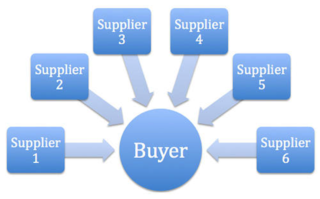
The economy of Slovakia is based upon Slovakia becoming an EU member state in 2004, and adopting the euro at the beginning of 2009. Its capital, Bratislava, is the largest financial centre in Slovakia. As of Q1 2018, the unemployment rate was 5.72%.

Marketing is the act of satisfying and retaining customers. It is one of the primary components of business management and commerce.
Procurement is the process of locating and agreeing to terms and purchasing goods, services, or other works from an external source, often with the use of a tendering or competitive bidding process. The term may also refer to a contractual obligation to "procure", i.e. to "ensure" that something is done. When a government agency buys goods or services through this practice, it is referred to as government procurement or public procurement.
E-procurement is a collective term used to refer to a range of technologies which can be used to automate the internal and external processes associated with procurement, strategic sourcing and purchasing.

Business-to-business is a situation where one business makes a commercial transaction with another. This typically occurs when:

Bid rigging is a fraudulent scheme in a procurement action which enables companies to submit non-competitive bids. It can be performed by corrupt officials, by firms in an orchestrated act of collusion, or by officials and firms acting together. This form of collusion is illegal in most countries. It is a form of price fixing and market allocation, often practiced where contracts are determined by a call for bids, for example in the case of government construction contracts. The typical objective of bid rigging is to enable the "winning" party to obtain contracts at uncompetitive prices. The other parties are compensated in various ways, for example, by cash payments, or by being designated to be the "winning" bidder on other contracts, or by an arrangement where some parts of the successful bidder's contract will be subcontracted to them. In this way, they "share the spoils" among themselves. Bid rigging almost always results in economic harm to the agency which is seeking the bids, and to the public, who ultimately bear the costs as taxpayers or consumers.
Business marketing is a marketing practice of individuals or organizations. It allows them to sell products or services to other companies or organizations, who either resell them, use them in their products or services, or use them to support their work.
Industrial marketing or business-to-business marketing is the marketing of goods and services by one business to another. Industrial goods are those an industry uses to produce an end product from one or more raw material. The term industrial marketing has largely been replaced by the term business-to-business marketing (B2B).
Government procurement or public procurement is undertaken by the public authorities of the European Union (EU) and its member states in order to award contracts for public works and for the purchase of goods and services in accordance with principles derived from the Treaties of the European Union. Such procurement represents 13.6% of EU GDP as of March 2023, and has been the subject of increasing European regulation since the 1970s because of its importance to the European single market.
Sustainable procurement or green procurement is a process whereby organizations meet their needs for goods, services, works and utilities in a way that achieves value for money on a life-cycle basis while addressing equity principles for sustainable development, therefore benefiting societies and the environment across time and geographies. Procurement is often conducted via a tendering or competitive bidding process. The process is used to ensure the buyer receives goods, services or works for the best possible price, when aspects such as quality, quantity, time, and location are compared. Procurement is considered sustainable when organizations broadens this framework by meeting their needs for goods, services, works, and utilities in a way that achieves value for money and promotes positive outcomes not only for the organization itself but for the economy, environment, and society.
Government procurement or public procurement is when a governing body purchases goods, works, and services from an organization for themselves or the taxpayers. In 2019, public procurement accounted for approximately 12% of GDP in OECD countries. In 2021 the World Bank Group estimated that public procurement made up about 15% of global GDP. Therefore, government procurement accounts for a substantial part of the global economy.
Health Marketing is a discipline that employs traditional marketing techniques and research-driven strategies to protect and promote the health of diverse communities. This multidisciplinary field blends elements from public health promotion, marketing, and communications to deliver vital health information to the public. When employed by the public sector, it promotes public awareness of preventive measures, health promotion initiatives, and health protection services. When used by the private sector, health marketing can increase market awareness of a new treatment or therapy, both at the provider and consumer levels.
Customer to customer markets provide a way to allow customers to interact with each other. Traditional markets require business to customer relationships, in which a customer goes to the business in order to purchase a product or service. In customer to customer markets, the business facilitates an environment where customers can sell goods or services to each other. Other types of markets include business to business (B2B) and business to customer (B2C).
The Common Procurement Vocabulary (CPV) has been developed by the European Union to facilitate the processing of invitation to tender published in the Official Journal of the European Union (OJEU) by means of a single classification system to describe the subject matter of public contracts. It was established by Regulation (EC) No 2195/2002 of the European Parliament and of the Council on the Common Procurement Vocabulary (CPV) and amended by European Commission Regulation (EU) No. 213/2008 issued on 28 November 2007.

A reverse auction is a type of auction in which the traditional roles of buyer and seller are reversed. Thus, there is one buyer and many potential sellers. In an ordinary auction also known as a forward auction, buyers compete to obtain goods or services by offering increasingly higher prices. In contrast, in a reverse auction, the sellers compete to obtain business from the buyer and prices will typically decrease as the sellers underbid each other.

An invitation to tender is a formal, structured procedure for generating competing offers from different potential suppliers or contractors looking to obtain an award of business activity in works, supply, or service contracts, often from companies who have been previously assessed for suitability by means of a supplier questionnaire (SQ) or pre-qualification questionnaire (PQQ).
Electronic invoicing is a form of electronic billing. E-invoicing includes a number of different technologies and entry options and is usually used as an umbrella term to describe any method by which a document is electronically presented from one party to another, either for payment or to present and monitor transactional documents between trade partners to ensure the terms of their trading agreements are being met. These documents can include invoices, purchase orders, debit notes, credit notes, payment terms, payment instructions, and remittance slips.
There are many types of e-commerce models, based on market segmentation, that can be used to conducted business online. The 6 types of business models that can be used in e-commerce include: Business-to-Consumer (B2C), Consumer-to-Business (C2B), Business-to-Business (B2B), Consumer-to-Consumer (C2C), Business-to-Administration (B2A), and Consumer-to-Administration
The Finnish Competition and Consumer Authority is the Competition regulator in Finland. It is the regulatory authority of Politics of Finland which works in the field of competition and consumer rights protection. The purpose of the Finnish Competition and Consumer Authority is to create healthy and effective markets in which companies and other operators act responsibly and in keeping with consumers' interests.
At around £290 billion every year, public sector procurement accounts for around a third of all public expenditure in the UK. EU-based laws continue to apply to government procurement: procurement is governed by the Public Contracts Regulations 2015, Part 3 of the Small Business, Enterprise and Employment Act 2015, and the Public Contracts (Scotland) Regulations of 2015 and 2016. These regulations implement EU law, which applied in the UK prior to Brexit, and also contain rules known as the "Lord Young Rules" promoting access for small and medium enterprise (SMEs) to public sector contracts, based on Lord Young's Review Growing Your Business, published in 2013.





